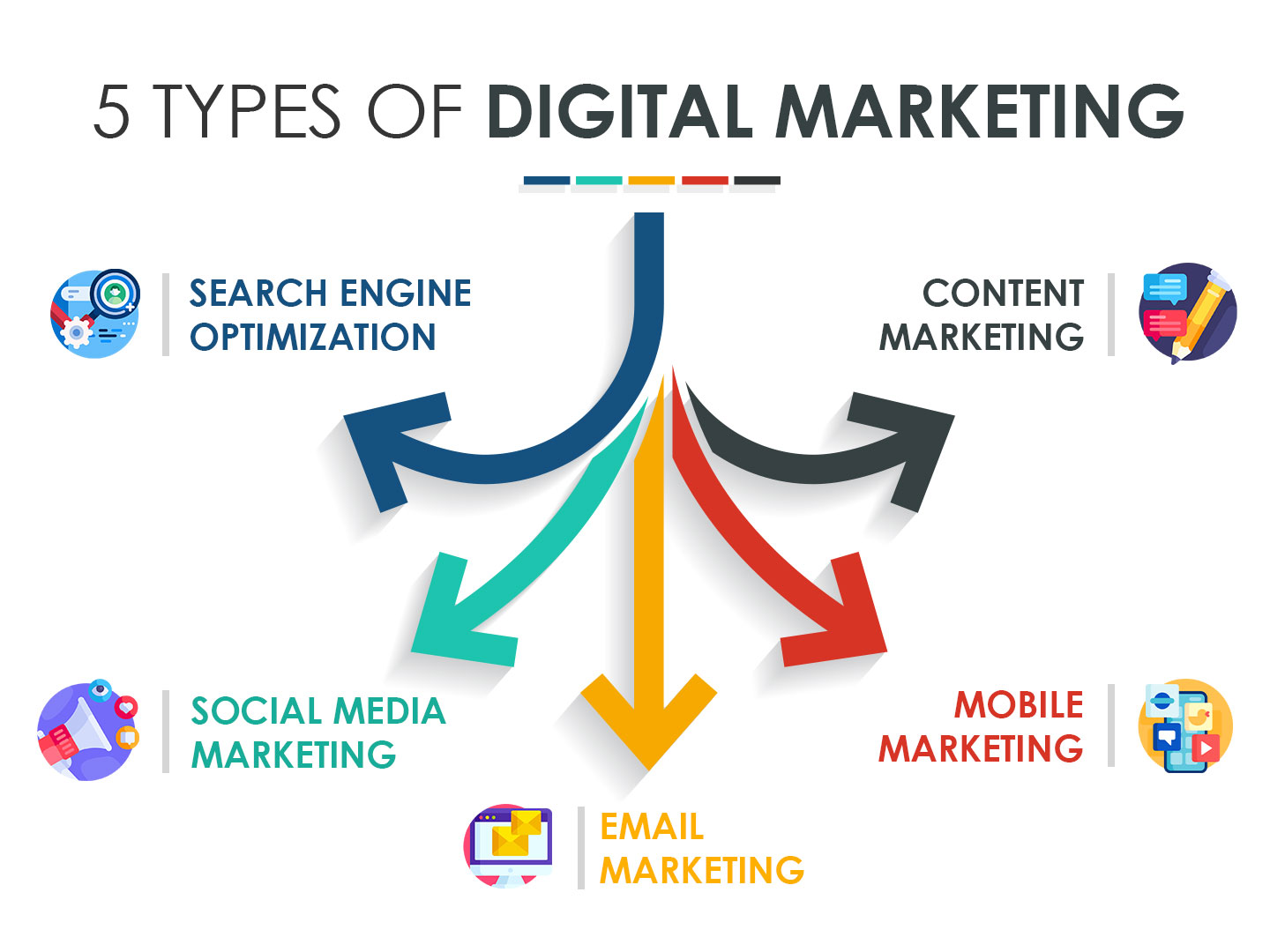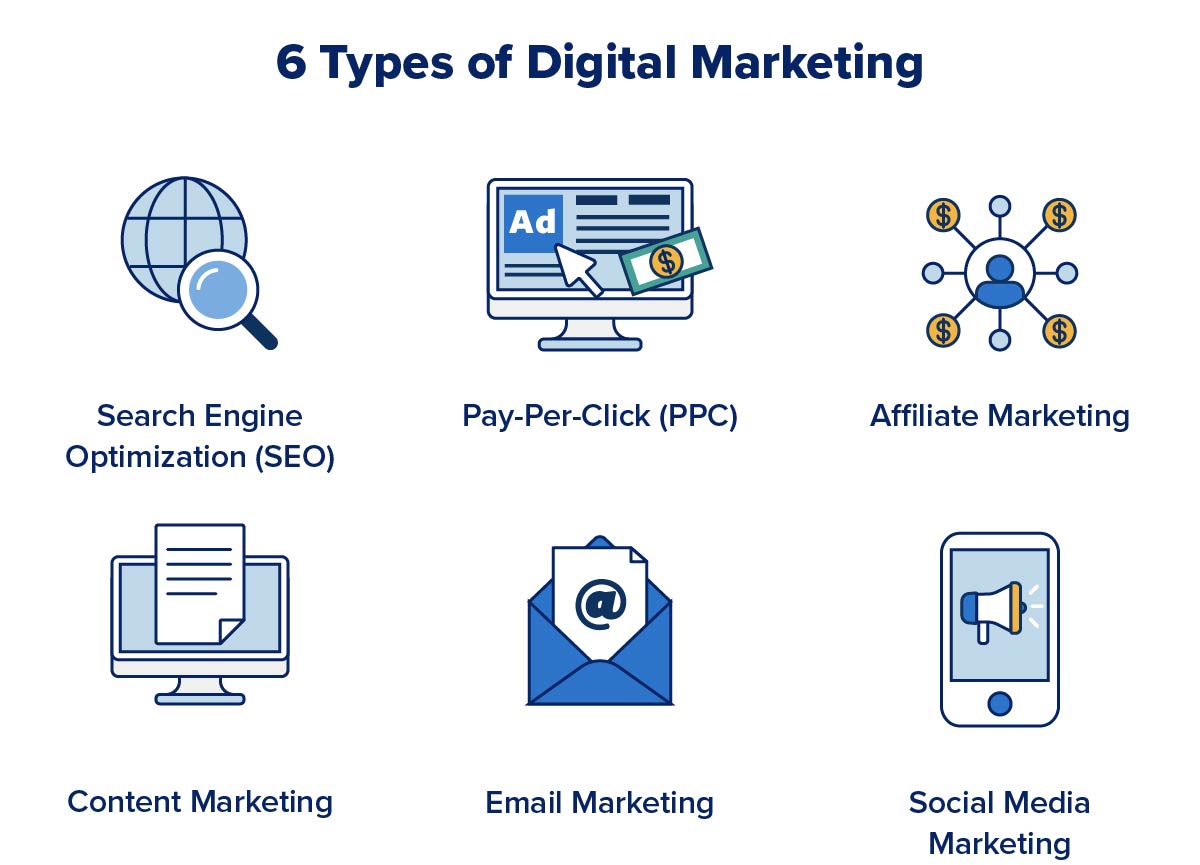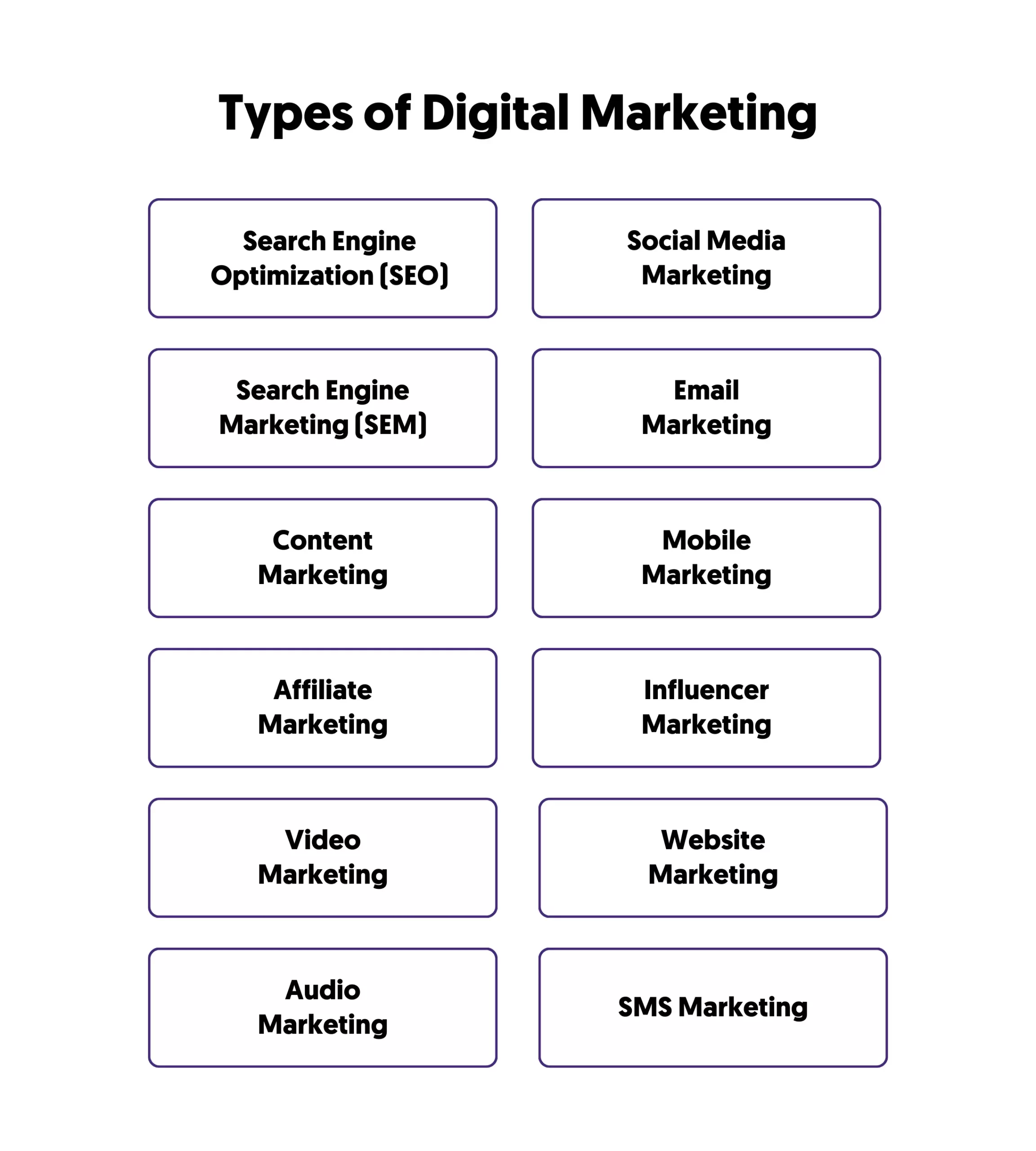Digital marketing allows companies to connect with their target audience through various online channels. Each type of digital marketing has its unique advantages, and businesses need to determine which tactics will work best for their specific needs. For example, social media marketing can help businesses increase brand awareness and engage with their audience, while email marketing can help companies nurture leads and turn them into customers.
By understanding the different types of digital marketing, businesses can create a comprehensive strategy to reach their marketing goals.
Introduction To Digital Marketing
Digital marketing is an essential strategy for businesses to reach their target audience. With the evolving landscape of online promotion, businesses can utilize various channels such as social media, search engines, and email to connect with potential customers. The key benefits of digital marketing for businesses include increased brand visibility, targeted advertising, and the ability to track and measure campaign performance. Through digital marketing, businesses can engage with their audience in real time and create personalized experiences. By leveraging digital marketing tactics, businesses can drive website traffic, generate leads, and ultimately increase sales and revenue.

Credit: tscfm.org
Content Marketing: King Of Engagement
Content marketing is a crucial aspect of digital marketing. It involves creating valuable and relevant content to engage and attract the target audience. By providing quality content, businesses can build trust and establish themselves as industry leaders.
Effective distribution strategies are essential for content marketing success. This includes utilizing various channels such as social media, email, and SEO to reach the right audience at the right time. By leveraging these strategies, businesses can maximize the impact of their content and drive meaningful engagement.
Search Engine Optimization (seo)
| Types of Digital Marketing | |
|---|---|
| Search Engine Optimization (SEO) | |
| Mastering On-Page and Off-Page Tactics | |
| SEO plays a crucial role in driving organic growth for businesses. By optimizing both on-page and off-page elements, companies can improve their website’s visibility in search engine results pages (SERPs).
On-page tactics involve optimizing webpage content, meta tags, and URLs to ensure search engines can understand and rank the site appropriately. This includes keyword research, proper title and header tags, and engaging, informative content. Off-page tactics, on the other hand, focus on building high-quality backlinks and establishing a strong online presence through social media, guest blogging, and influencer partnerships. By generating relevant and authoritative links, businesses can boost their website’s credibility and improve search engine rankings. Mastering both on-page and off-page SEO techniques is essential for businesses looking to increase organic traffic, attract targeted audiences, and boost their online visibility. |
Pay-per-click Advertising (ppc)
Pay-Per-Click Advertising (PPC) is a type of digital marketing where advertisers pay for each click on their ads. It includes search ads, display ads, social media ads, and remarketing ads. PPC advertising is an effective way to drive traffic, increase leads, and boost sales for businesses.
Pay-Per-Click Advertising (PPC) is an essential component of digital marketing strategies, aimed at maximizing Return on Investment (ROI). By utilizing PPC, businesses can increase their online visibility and drive targeted traffic to their websites. With PPC, advertisers only pay when their ads are clicked, making it a cost-effective method for reaching potential customers.
To run successful paid search campaigns, it is crucial to focus on a few essentials. First, conducting thorough keyword research is vital to identify relevant and high-performing keywords. These keywords should align with the business objectives and target audience. Second, crafting compelling ad copy that captures attention and encourages clicks is essential. A strong call-to-action and clear value proposition can significantly impact campaign performance. Lastly, continuously monitoring and optimizing campaigns based on performance data is crucial for maximizing ROI. Regularly analyzing metrics such as click-through rates (CTR) and conversion rates can help identify areas for improvement and refine the campaign strategy.
Social Media Marketing
Social Media Marketing is a type of digital marketing that involves promoting products or services through social media platforms. It includes creating engaging content, running ads, and building a community of followers to increase brand awareness and drive sales.
| Types of Digital Marketing |
|---|
Harnessing The Power Of Social NetworksSocial media platforms like Facebook, Twitter, Instagram, and LinkedIn offer businesses an unprecedented opportunity to connect with customers and build relationships. To harness the power of social networks, it’s important to understand your target audience and what type of content they engage with. Create a social media strategy that aligns with your business goals and brand voice. Consistency is key, so post regularly and engage with your audience through comments and direct messages. Use analytics to track your success and adjust your strategy as needed. Crafting Campaigns For Viral SuccessGoing viral on social media can be a game-changer for your business. To increase your chances of success, create campaigns that are unique, visually appealing, and shareable. Use humor, emotion, or controversy to grab attention and encourage sharing. Partner with influencers or collaborate with other businesses to expand your reach. Remember that going viral isn’t a guarantee of long-term success, so focus on creating quality content that resonates with your audience. |

Credit: bootcamp.cvn.columbia.edu
Email Marketing: Personalized Outreach
Personalized outreach through email marketing is a powerful tool in the digital marketing arsenal. By tailoring content to individual recipients, businesses can forge stronger connections and drive engagement. This targeted approach can lead to higher conversion rates and a more personalized customer experience.
Email marketing is a form of direct marketing that uses email to promote products or services. Building and nurturing subscriber lists is the first step in email marketing. To build a subscriber list, you need to have a sign-up form on your website, social media pages or blog. The sign-up form should be easy to fill out and offer an incentive for subscribers to sign up.
Once you have a subscriber list, the next step is to design high-converting email campaigns. High-converting email campaigns are those that get a high response rate from subscribers. To design a high-converting email campaign, you need to personalize the outreach. Personalization means using the subscriber’s name and other details in the email. It also means sending targeted messages to specific segments of your subscriber list.
| Building and Nurturing Subscriber Lists | Designing High-Converting Email Campaigns |
|---|---|
| Have a sign-up form on your website, social media pages or blog | Personalize the outreach by using the subscriber’s name and other details in the email |
| Offer an incentive for subscribers to sign up | Send targeted messages to specific segments of your subscriber list |
Affiliate Marketing: Partnerships For Growth
Affiliate marketing is a powerful strategy for businesses to expand their reach and increase sales. By developing profitable affiliate networks, companies can leverage the influence and reach of their partners to drive traffic and generate leads. The key to success lies in tracking and optimizing affiliate performance.
Tracking affiliate performance allows businesses to monitor the effectiveness of their partnerships and identify areas for improvement. By analyzing metrics such as click-through rates, conversion rates, and revenue generated, companies can make data-driven decisions to optimize their affiliate programs.
Optimizing affiliate performance involves identifying top-performing affiliates and nurturing those relationships. Providing affiliates with the necessary resources, such as promotional materials and exclusive offers, can incentivize them to drive more traffic and generate higher conversions. Regular communication and feedback can also help strengthen partnerships and ensure mutual growth.
In conclusion, affiliate marketing is a valuable strategy for businesses seeking to expand their online presence and drive sales. By developing profitable affiliate networks and tracking and optimizing affiliate performance, companies can unlock the full potential of this marketing channel.
Influencer Marketing: Celebrity Endorsements
Influencer marketing has become a popular strategy for brands to reach their target audience. One effective approach is through celebrity endorsements, where well-known personalities promote products or services to their followers. Identifying the right influencers is crucial for the success of such collaborations.
When selecting influencers, brands should consider their relevance to the industry, values, and target audience. It’s important to look beyond follower count and examine engagement rates and authenticity. Micro-influencers with a smaller following but higher engagement can often be more impactful.
Once the influencers are chosen, measuring the impact of the collaborations is essential. Brands can track metrics like website traffic, sales conversions, social media engagement, and brand mentions to assess the effectiveness of the campaign.
In conclusion, influencer marketing through celebrity endorsements can be a powerful tool for brands to increase their reach and connect with their target audience. By carefully selecting the right influencers and measuring the impact of collaborations, brands can maximize the success of their influencer marketing campaigns.
Mobile Marketing: Reaching Customers On-the-go
Mobile marketing allows businesses to reach customers on-the-go, taking advantage of trends in mobile usage and advertising. Techniques such as geotargeting and SMS marketing can be highly effective in engaging mobile users. Mobile video ads and in-app advertising are also popular methods for capturing the attention of mobile audiences. With the increasing use of smartphones and mobile apps, businesses are focusing on creating responsive websites and mobile-friendly content to enhance the mobile user experience. Leveraging location-based services and push notifications can further boost the impact of mobile marketing efforts.
 Credit: www.reliablesoft.net
Credit: www.reliablesoft.net
Video Marketing: Engaging Visuals
Video marketing is an essential component of digital marketing. Crafting compelling video content is crucial for capturing audience attention. Utilizing platforms such as YouTube, Facebook, and Instagram can provide maximum exposure for your videos, reaching diverse audiences. Engaging visuals and storytelling are key to creating impactful video content. Implementing creative and informative videos can effectively convey your brand message and drive engagement. Leveraging video marketing can enhance your digital marketing strategy and boost brand awareness.
Web Analytics: Measuring Success
In the realm of digital marketing, web analytics plays a crucial role in assessing the success of marketing efforts. By tracking key metrics, businesses can gain valuable insights into their website’s performance and make informed marketing decisions. These metrics provide a deep understanding of user behavior, allowing marketers to optimize their strategies for better results.
When it comes to web analytics, there are several key metrics that businesses should track. One important metric is website traffic, which indicates the number of visitors a website receives. This data helps measure the effectiveness of marketing campaigns in attracting potential customers.
Another vital metric is bounce rate, which reveals the percentage of visitors who leave a website after viewing only one page. A high bounce rate could indicate issues with website design or irrelevant content, prompting the need for improvements.
Conversion rate is yet another essential metric that measures the percentage of website visitors who take a desired action, such as making a purchase or filling out a form. Monitoring this metric helps identify areas for optimization and conversion rate improvement.
By utilizing web analytics data, businesses can uncover valuable insights to guide their marketing strategies. These insights enable marketers to make data-driven decisions, optimize campaigns, and achieve better results in the dynamic world of digital marketing.
Conclusion: Integrating Digital Marketing Strategies
Conclusion: Integrating digital marketing strategies is crucial for creating a cohesive online presence. By combining various digital marketing channels such as social media, content marketing, and SEO, businesses can establish a unified brand image and engage with their target audience effectively.
Future trends in digital marketing indicate the growing significance of personalized marketing, voice search optimization, and artificial intelligence. Embracing these advancements will be essential for staying ahead in the competitive digital landscape and reaching consumers in innovative ways.
Frequently Asked Questions
What Are The 8 Types Of Digital Marketing?
The 8 types of digital marketing include search engine optimization (SEO), search engine marketing (SEM), content marketing, social media marketing, influencer marketing, email marketing, affiliate marketing, and mobile marketing. These strategies help businesses reach their target audience and promote their products or services online.
What Are The Top 7 Types Of Digital Marketing?
The top 7 types of digital marketing are: 1. Search Engine Optimization (SEO) 2. Content Marketing 3. Social Media Marketing 4. Email Marketing 5. Influencer Marketing 6. Pay-Per-Click (PPC) 7. Affiliate Marketing.
What Are The 9 Types Of Digital Marketing?
The nine types of digital marketing are: search engine optimization (SEO), content marketing, social media marketing, pay-per-click (PPC), affiliate marketing, influencer marketing, email marketing, viral marketing, and mobile marketing.
What Are The 7 Areas Of Digital Marketing?
The 7 areas of digital marketing include search engine optimization (SEO), social media marketing, content marketing, email marketing, mobile marketing, pay-per-click (PPC) advertising, and analytics and reporting. These strategies help businesses reach their target audience, increase website traffic, and generate leads.
Conclusion
Understanding the different types of digital marketing is crucial for businesses. By leveraging the right strategies, such as social media marketing, SEO, and content marketing, companies can reach their target audience effectively. Embracing these digital marketing methods can lead to increased brand awareness, engagement, and ultimately, business growth.